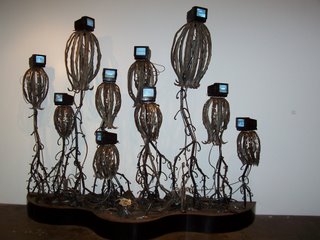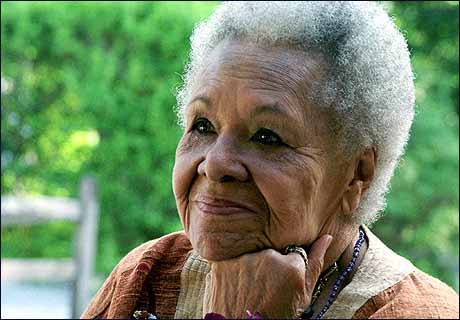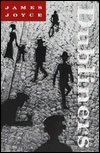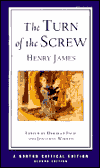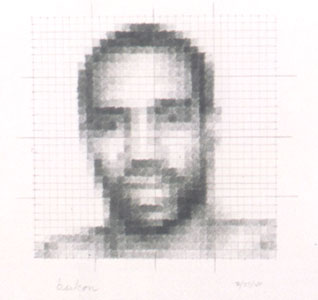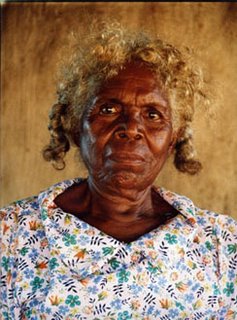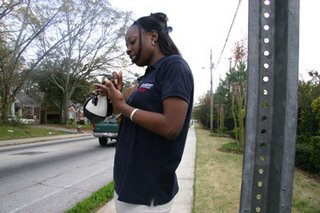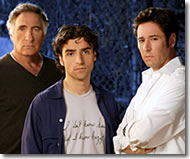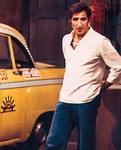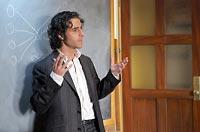End of Month Film Report: May 2006 Part I
I decided that I would try to keep track of the films I'm watching each month. It's a somewhat electic list, some for research, some for fun, some "I've been meaning to see that," some that are "should watches": the films that should be seen for ones own aptitude, intellectual development, facility for small-talk, etc. But what emerged is my growing penchant for films by directors who create powerful visuals from everyday moments and have an acute sense of the use of sound. Here they are in order of my memory which has no bearing on my enjoyment (or lack thereof):
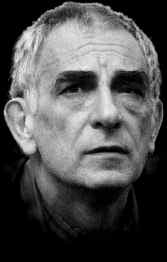
1. Trois Couleurs: Bleu (1993), Blanc (1994), Rouge (1994), Dir. Krzysztof Kieslowski (pictured left). Kieslowski's mediation on France's national ethos: Liberty, Equality, and Fraternity. Each idea is represented in order by a color from the national flag. The individual installments are
 astounding in their own right, but for me Trois Couleurs: Bleu is tied with Ratcatcher (#6) as my most riveting viewing for the month. Like Ratcatcher, this film is about loss, grief, and love, but in this case from the point of view of a woman (Juliette Binoche) who has lost her composer husband and only child and attempts to liberate herself from all human attachment. Kieslowski is one of my favorite visual storytellers. An exciting aspect of this DVD series are the film lessons where Kieslowski breaks down the aesthetic reasoning and technological methods of an individual shot. This series also features his early short films including student work from his days at the prestigious Lódz Film School in Poland. I found Kieslowski's portrait profoundly moving. If you want to see my thoughts on this film see my post "For C. and my friend" from May 26th.
astounding in their own right, but for me Trois Couleurs: Bleu is tied with Ratcatcher (#6) as my most riveting viewing for the month. Like Ratcatcher, this film is about loss, grief, and love, but in this case from the point of view of a woman (Juliette Binoche) who has lost her composer husband and only child and attempts to liberate herself from all human attachment. Kieslowski is one of my favorite visual storytellers. An exciting aspect of this DVD series are the film lessons where Kieslowski breaks down the aesthetic reasoning and technological methods of an individual shot. This series also features his early short films including student work from his days at the prestigious Lódz Film School in Poland. I found Kieslowski's portrait profoundly moving. If you want to see my thoughts on this film see my post "For C. and my friend" from May 26th.
2. La Ciénaga/The Swamp (2001), Dir. Lucrecia Martel. I wrote about Martel's latest, La Niña santa/The Holy Girl (2004) in April. Her first film is filled with small details of middle-class family life in Argentina, for Martel a stagnant unattended pool by which everyone lays in the sweltering heat serves as apt metaphor. Here again Martel's use of sound as connective tissue between scenes and to underscore specific narrative elements is key. Change or die, as the saying goes and the people in these two related families seem to be dying in degrees. Martel's screenplay is also notable for the prolific and brutal anti-Indian sentiment voiced by the family who has Indian domestics in their employ. Even in the case of the adolescent daughter who clings to the Indian maid who is near her own age, her affection stems from the deep loneliness she feels within her family not a true embrace of this young woman whose livelihood is tethered to the efficacy of the daughter's care. Amazing performances, but I was relieved leave their quicksand lives at the film's end.
3. Possession (2002), Dir. Neil LaBute. From the Booker Prize winning novel by A.S. Byatt (which I haven't read). I really didn't expect a thoughtful adult consideration of the consequences of consuming passion from the director known for comedies of human cruelity: In the Company of Men (1997) and The Shape of Things (2003). Of course in between he made Nurse Betty (2000), pulling a good performance out of Chris Rock(!) and giving Morgan Freeman the opportunity to play a philosopher with the heart of a romantic who also happens to be a hitman. I'm not a big Gwyneth Paltrow fan except when she's playing British which she does here, in the end it was playwright David Henry Hwang's name among the screenwriters that sucked me in. I was glad for it because when do you get to see a well written and directed film about the complex politics of academia, even if it is couched in romance mystery?
4. Pride and Prejudice (2005), Dir. Joe Wright. Lush and romantic (so is the score), and yet shot in a naturalistic style--the actors looked as though they were actually living their characters' lives as opposed to stepping out of a rarified photo shoot. Wright enjoys his actors, in particular Kiera Knightly, and clearly finds pleasure in telling an intelligent romantic story and taking advantage of some great locations despite weather and lighting vagaries. Emma Thompson helped in places with the dialogue, and it shows. As director Gurinder Chadha (Bend It Like Beckham) predicted, Knightly is among the promising new talents, and the camera loves her.

5. Something New (2006), Dir. Sanaa Hamri. Hopefully the beginning of an interesting career for Hamri who shows herself to have a great sense of color and light, and the maturity to just let the camera stay on Sanaa Lathan and trust this gifted and astute actor work her craft from the inside out. Also fine efforts by supporting actors, particularly Alfre Woodard as a propriety-devoted mother, and Wendy Raquel Robinson (pictured below right with Lathan), who is best known as Steve Harvey's romantic foil on his eponymous TV show, getting to stretch her wings as the thoughtful best friend who goes through her own character growth.
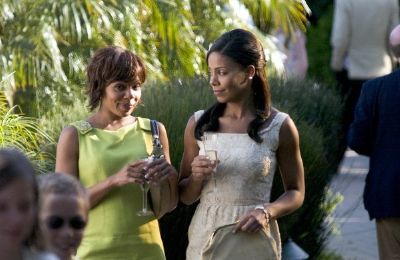 Plus a great monologue by Earl Billings as the perceptive and big-hearted father (the role plays as a daughter's love-letter to all black fathers). Simon Baker is under-utilized here, but gives a solid performance as the romantic lead. Baker has some compelling skills. An understated actor, he tends to disappear into his characters; he just needs some better ones to evaporate into. Baker had a nuanced performance in the well-written and underappreciated, debut effort by Alan Brown (best know for the innovative queer short O Beautiful), Book of Love (2004). But nevermind the boys (Mike Epps showing his romantic side, Donald Faison, and Blair Underwood as the I.B.M.--Ideal Black Man)--they're part of screenwriter Kriss Turner's fantasy--this is a women's film in the classic sense and Lathan's vehicle in the best sense. A subtle, romantic score by Wendy & Lisa, and points for inclusion and placement of the funk classic "Look What You've Done to Me" by Sheila Skipworth.
Plus a great monologue by Earl Billings as the perceptive and big-hearted father (the role plays as a daughter's love-letter to all black fathers). Simon Baker is under-utilized here, but gives a solid performance as the romantic lead. Baker has some compelling skills. An understated actor, he tends to disappear into his characters; he just needs some better ones to evaporate into. Baker had a nuanced performance in the well-written and underappreciated, debut effort by Alan Brown (best know for the innovative queer short O Beautiful), Book of Love (2004). But nevermind the boys (Mike Epps showing his romantic side, Donald Faison, and Blair Underwood as the I.B.M.--Ideal Black Man)--they're part of screenwriter Kriss Turner's fantasy--this is a women's film in the classic sense and Lathan's vehicle in the best sense. A subtle, romantic score by Wendy & Lisa, and points for inclusion and placement of the funk classic "Look What You've Done to Me" by Sheila Skipworth.
6. Ratcatcher (1998), Dir. Lynne Ramsay (pictured left). Tied with #1, Trois Couleurs: Bleu for the films
 I was most riveted by this month. The story of a boy from a working class Glasgow neighborhood living in an enviroment made toxic by economic limitations and the strife of the ongoing garbage collector strike. Ramsay is a truly gifted visual storyteller, consistently able to draw natural, and brutally honest, portrayals from children and adolescents
I was most riveted by this month. The story of a boy from a working class Glasgow neighborhood living in an enviroment made toxic by economic limitations and the strife of the ongoing garbage collector strike. Ramsay is a truly gifted visual storyteller, consistently able to draw natural, and brutally honest, portrayals from children and adolescents  both actors and non-actors (if you get the Criterion Collection DVD it includes her award-winning short films Gasman and Small Deaths both told from the p.o.v. of working-class Scottish children). There are no wasted words in her dialogue, and her use of sound is evocative and unsettling.
both actors and non-actors (if you get the Criterion Collection DVD it includes her award-winning short films Gasman and Small Deaths both told from the p.o.v. of working-class Scottish children). There are no wasted words in her dialogue, and her use of sound is evocative and unsettling.7. Morven Callar (2002), Dir. Lynne Ramsay. Adapted from Alan Warner's novel about a supermarket clerk in Scotland whose writer boyfriend has committed suicide leaving her his unpublished novel which she passes off as her own, taking the sizable payment to live as a raver in Spain. Not as successful as Ratcatcher, but Samantha Morton is a revelation as the title character, and a partially realized Ramsay vision is still quite intriguing to watch. Again, great pairing of sound and image, particularly the use of headphone audio effect in the main character's development.
8. Tom Dowd and the Language of Music (2003), Dir. Mark Moormann. Dowd (pictured left) was a
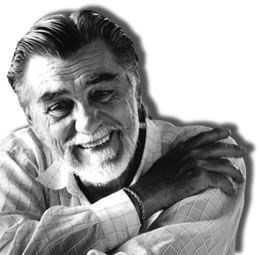 brilliant and sensitive, multi-talented sound engineer (and a former researcher with the Manhattan Project). Working with Ray Charles, Aretha Franklin, John Coltrane, Theolonius Monk, Otis Redding, Eric Clapton, the Allman Brothers, Lynyrd Skynyrd, and others Dowd contributed his engineering and mixing talents some of the most important music of the 1950s, 60s and 70s. He was a fascinating man, research scientist, and inventor with a great ear who was at the cutting edge of analog recording during his time and who embraced digital recording as well. Hearing him speak about his work with artists was enthralling, particularly seeing him walk through the mix of Eric Clapton's "Layla" some thirty years after his original engineering of the tracks.
brilliant and sensitive, multi-talented sound engineer (and a former researcher with the Manhattan Project). Working with Ray Charles, Aretha Franklin, John Coltrane, Theolonius Monk, Otis Redding, Eric Clapton, the Allman Brothers, Lynyrd Skynyrd, and others Dowd contributed his engineering and mixing talents some of the most important music of the 1950s, 60s and 70s. He was a fascinating man, research scientist, and inventor with a great ear who was at the cutting edge of analog recording during his time and who embraced digital recording as well. Hearing him speak about his work with artists was enthralling, particularly seeing him walk through the mix of Eric Clapton's "Layla" some thirty years after his original engineering of the tracks.9. Mar adentro/The Sea Inside (2003), Dir. Alejandro Amenabar. I had been avoiding
 this, as I wasn't sure if it was actually any good or if it had earned the Foreign Film Oscar because more Academy voters viewed it due to their recognition of lead Javier Bardem (Before Night Falls), and director Amenabar (The Others) given their respective successes on US movie screens. Bardem was compelling and nuanced, in matter of fact manner (which is harder than it sounds) playing a paraplegic, Ramón Sampedro, who fought for his right to die legally in post-Franco Spain. Bardem exhibits Sampedro's calm certainty
this, as I wasn't sure if it was actually any good or if it had earned the Foreign Film Oscar because more Academy voters viewed it due to their recognition of lead Javier Bardem (Before Night Falls), and director Amenabar (The Others) given their respective successes on US movie screens. Bardem was compelling and nuanced, in matter of fact manner (which is harder than it sounds) playing a paraplegic, Ramón Sampedro, who fought for his right to die legally in post-Franco Spain. Bardem exhibits Sampedro's calm certainty without resorting to the noble victim. Amenabar (pictured right with Bardem) captures wonderful moments from a number of relatively unknown and untested (at least at this level of performance) actors, while finding innovative ways to keep the camera from being static yet still communicating the sense of immobility and dependence that for Sampedro defined his life. Amenabar, who neither reads music nor has any formal training, also composed the film's score (as he has on all his films to date). Clearly atuned to sound, he acheives some powerfully sensual interweaving of waves and breath in the film's sound design.
without resorting to the noble victim. Amenabar (pictured right with Bardem) captures wonderful moments from a number of relatively unknown and untested (at least at this level of performance) actors, while finding innovative ways to keep the camera from being static yet still communicating the sense of immobility and dependence that for Sampedro defined his life. Amenabar, who neither reads music nor has any formal training, also composed the film's score (as he has on all his films to date). Clearly atuned to sound, he acheives some powerfully sensual interweaving of waves and breath in the film's sound design.